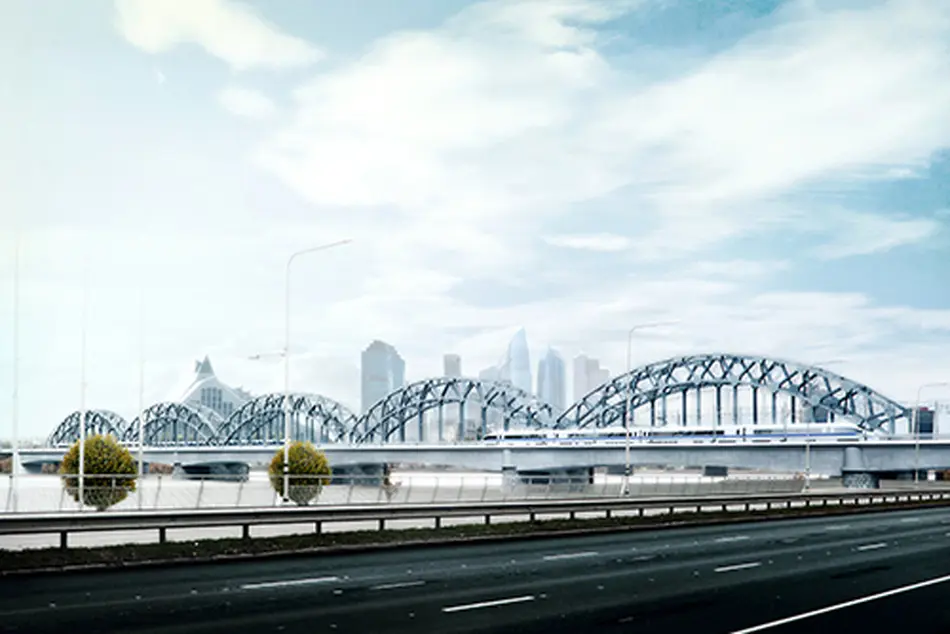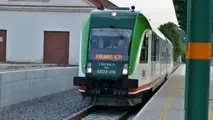Rail Baltica - Building a bridge to the European standard-gauge network

Momentum is building behind the ambitious Rail Baltica project, which aims to construct an 870km standard-gauge 240km/h mixed-traffic railway linking the Baltic state capitals with Poland and the broader European railway network. David Briginshaw reports from the Latvian capital Riga on progress so far.
While Estonia, Latvia and Lithuania are served by a 1520mm-gauge rail network, freight traffic flows are mainly east-west to Russia and Belarus reflecting their Soviet past and the fact that traffic to Poland and the rest of the European Union requires a change of gauge at the Lithuanian-Polish border. There are currently no cross-border passenger trains between the three Baltic states as passenger rail services are largely focused on commuter services around the three capitals and limited regional services.
The Rail Baltica project is designed to address these deficiencies by constructing a north-south standard-gauge railway from Talinn, via Riga and Riga Airport, to a junction near Lithuania’s second-largest city Kaunas where the line would split to serve the capital Vilnius and to connect with the Polish network near Trakiszki. The 870km railway would be double-track throughout, electrified at 25kV ac and equipped with ETCS Level 2. It would be a mixed-traffic railway designed for operation by 120km/h freight trains and 240km/h passenger trains.
The total cost of the project is estimated at €5.79bn. The European Union (EU) is expected to fund the bulk of the project with contributions totalling €4.634bn leaving the three national governments to fund the remaining €1.154bn.
According to a cost:benefit analysis conducted by Ernst & Young Baltic, Rail Baltica is financially and economically viable. “Rail Baltica has a 6.32% economic rate of return, which is above the 5% EU threshold required for funding,” says Mr Nauris Klava, a director of Ernst & Young Baltic. This rate of return is for the base case scenario, but even the low case scenario has a rate of return of 5.05%, while the high case scenario return is forecast at 7.7%. Measurable socio-economic benefits of the project are estimated at €16.2bn, which far outweighs the investment. It is also estimated that Rail Baltica would create a GDP multiplier effect worth an additional €2bn.
“The forecasts are based on continuous economic growth and that the EU’s policy of shifting freight from road to rail happens,” Klava says. “We have not estimated the ticket prices because pricing will depend on the future policies of operators.”
Ernst & Young Baltic says that while Rail Baltica is not financially viable without public co-financing, once the investment has been made, the infrastructure manager should reach breakeven in 2031 and be financially sustainable thereafter.
The three Baltic states have a combined population of 6.2 million. Their GDP has increased by around 5% between 2006 and 2016 to reach €20.9bn in Estonia, €25bn in Latvia and €38.6bn in Lithuania, the largest of the three countries. “The Baltic states have recovered from the economic crisis of 2008-09, have exceeded the pre-crisis GDP level, and are expected to surpass the EU average GDP growth rate up to 2055,” says the cost:benefit analysis.
“Finland and Poland will gain from strengthened European connectivity,” says Ms Baiba Rubesa, CEO and chairperson of RB Rail, which has been set up by the three states to implement the project. “The five countries account for 19% of the land area and 10% of the population of the EU, and the route will serve around 600 higher-end institutions with 2.6 million students.”
Rail Baltica is expected to carry 2 million tonnes of freight in its first year of operation, rising to 13.7 million tonnes by 2030 and 20 million tonnes by 2055 under the base case scenario. Rail Baltica would offer a transit time of less than two days between the Baltic states and destinations within central Europe, compared with four days for the equivalent lorry journey.
Transit freight would account for 57% of traffic with the main flows coming from Finland via ferry links across the Baltic Sea and between Asia, Russia, Poland, Germany and the rest of Europe. The rest of the traffic would be imports and exports from Estonia (10% of total freight), Latvia (10%) and Lithuania (23%). Klava says the bulk of the freight traffic will be containers and high-value goods, which is very different from the type of traffic currently transported by rail in the Baltic states. Intermodal logistics terminals will be established in Muuga near Tallinn connecting the railway with the port, Salaspils near Riga, and Kaunas and Vilnius in Lithuania.
Up to 15 freight trains per day are expected to use Rail Baltica between Tallinn and Vilnius, rising to 22-31 trains per day on the section between Kaunas and the Polish border.
The predicted passenger flows will be very different from freight, as most of the traffic will be concentrated between the three capitals. In the base case scenario, Rail Baltica is expected to operate eight trains daily in each direction between Tallinn, Riga and Panevezys, rising to 10 between Panevezys and Kaunas, and up to 12 from Kaunas to Vilnius, while there are only expected to be five cross-border trains per day to Poland. In addition, a shuttle service of 36 trains per day per direction will be provided between Riga and Riga Airport.
“Rail Baltica will be a game changer for passengers,” Klava says. Journey times compared with driving will be slashed. Tallinn - Riga will be 1h 55min by train compared with 4h 5min by car, while Riga - Vilnius will take 2h 1min by rail rather than 3h 30min by road. The railway is expected to carry between 3.6 and 5.5 million passengers in its first year of operation, increasing to 4.7-7.1 million annual passengers by 2055, using figures from the low and high scenarios.
According to the cost:benefit analysis, Rail Baltica will be profitable to operate, particularly for freight (Table 3).
Progress is already being made with Rail Baltica. Work was completed last October on a €364.5m scheme to extend standard-gauge track 123km from the Polish border to Kaunas together with track renewals on the existing 1520mm-gauge line. However, as Rubesa pointed out, the project will have to be revisited. “The Polish border - Kaunas section is single and not double track, the speed is too low, and there is no decent signalling, so it needs to be upgraded to Rail Baltica standards.”
Rubesa told IRJ that the alignment from Kaunas to the Latvian-Estonian border has been fixed, and according
to Lithuania’s transport and communications minister Mr Rokas Masiulis, land appropriation as far as the Latvian border has started, and Lithuania has a compensation scheme in place for affected land owners. “Rail Baltica is entering the irreversible phase and the project will happen,” Masiulis asserts.
Rubesa says tendering to build the rail link from Riga Central to Riga Airport is already underway with a view to starting work next year. “Riga Central station is one of the most complex projects because of the bridges crossing the river and because it will be a massive redevelopment scheme,” Rubesa says. “It is worth taking more time in the capital cities to see where the commercial development opportunities are. Opportunities abound for private companies to become involved in the logistics centres.
“We have just completed the procurement guidelines and we expect to complete the design guidelines and finalise the alignment for Rail Baltica by the end of the year,” Rubesa explains.
“By the end of 2018, the joint venture partners will have to decide on an infrastructure manager, and we realise we need to get an operator on board as soon as possible.”
So far, Rail Baltica has secured €765m in funding. “We have submitted a CEF application which would bring it to just under €1bn for studies, technical design and preliminary works,” Rubesa says.
However, funding beyond 2021 is less certain, as Rubesa explains: “I don’t think anyone in the EU knows what financing will be like in a post-Brexit 2021 situation. It is possible to ensure we have sustainable financing over a long period, but we have to be prepared to look for alternatives.”
Earlier opposition to Rail Baltica is waning as people start to realise its benefits. “The railway is a catalyst for economic development,” says Latvia’s prime minister Mr Maris Kucinskis. “It will transform the economic geography of the three countries, increase exports and result in better supply routes.”
“The first train will leave Tallinn in 2026,” Rubesa says. “Children today will wonder how we managed without Rail Baltica.”
Upgrading Poland’s Baltic links
POLAND is making good progress to upgrade the line from Warsaw via Bialystok and Elk to the Lithuanian border at cost of between e1.76bn and e1.94bn.
On May 31, a €325m scheme to upgrade the 66km Warsaw - Sadowne section was completed. This included quadrupling the track in the Warsaw area to separate commuter and long-distance trains.
Work is due to start this year to upgrade the next two sections. The 36km €240m Sadowne - Czyzew section should be completed in 2020 with the 72km €393m Czyzew - Bialystok section following a year later. Line speed will be increased to 120km/h for freight and 160km/h passenger trains.
Poland has applied for funding from the EU’s Connecting Europe Facility (CEF) for up to 60% of the €395m required for the 105km Bialystok - Elk section where works are planned for 2020-2023. “Bialystok - Elk is single track and will be upgraded to a double-track electrified railway with a maximum speed of 160km/h,” says Mr Jakub Kapturzak, deputy director, rail transport with Poland’s Ministry of Infrastructure and Construction. It is also planned to install ETCS between Warsaw and Elk by 2023.
Plans to improve the final section from Elk via Olecko to the Lithuanian border are a little more uncertain. The line has a lot of curves which restrict the maximum speed. Two options are being considered to upgrade it for 140km/h operation to achieve a 50-minute journey time by 2024 at an estimated cost of €420m, or realign the railway for 160km/h running to reduce the journey time to 38 minutes by 2025 at an estimated cost of €600m.



